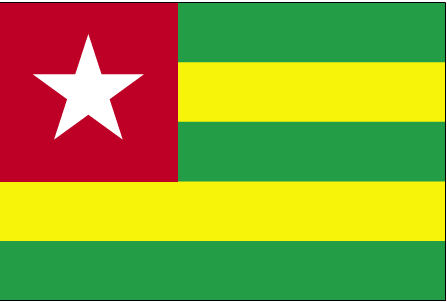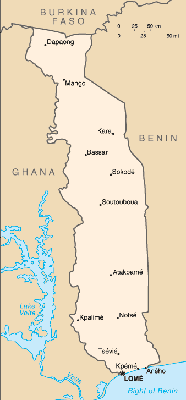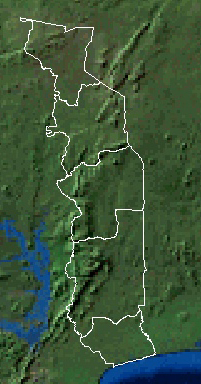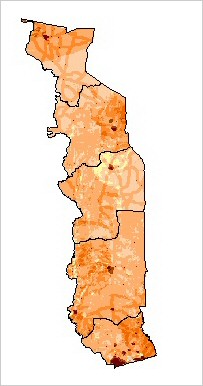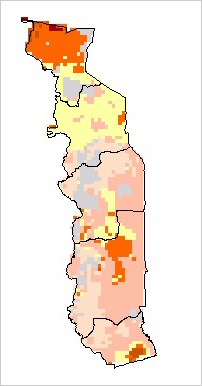|
|
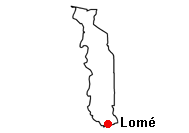 |
| back to top | |||
|
Population: Extinct. The species existed in the savannahs in the north of the country. Until the 1960’s there was probably a small population of cheetahs in Keran National Parc. |
|||
|
|
|||
|
|||
|
French Togoland became Togo in 1960. Gen. Gnassingbe EYADEMA, installed as military ruler in 1967, continued to rule well into the 21st century. Despite the facade of multiparty elections instituted in the early 1990s, the government continued to be dominated by President EYADEMA, whose Rally of the Togolese People (RPT) party has maintained power almost continually since 1967. Togo has come under fire from international organizations for human rights abuses and is plagued by political unrest. While most bilateral and multilateral aid to Togo remains frozen, the EU initiated a partial resumption of cooperation and development aid to Togo in late 2004 based upon commitments by Togo to expand opportunities for political opposition and liberalize portions of the economy. Upon his death in February 2005, President EYADEMA was succeeded by his son Faure GNASSINGBE. The succession, supported by the military and in contravention of the nation's constitution, was challenged by popular protest and a threat of sanctions from regional leaders. GNASSINGBE succumbed to pressure and in April 2005 held elections that legitimized his succession. Legislative elections are scheduled for June 2007. |
|||
| back to top | |
|
Area: total: 56,785 sq km; land: 54,385 sq km; water: 2,400 sq km Climate: tropical; hot, humid in south; semiarid in north Terrain: gently rolling savanna in north; central hills; southern plateau; low coastal plain with extensive lagoons and marshes Natural resources: phosphates, limestone, marble Land use: arable land: 44.2%; permanent crops: 2.11%; other: 53.69% (2005) Irrigated land: 70 sq km (2003) Natural hazards: hot, dry harmattan wind can reduce visibility in north during winter; periodic droughts Environment-current issues: deforestation attributable to slash-and-burn agriculture and the use of wood for fuel; recent droughts affecting agriculture Environment-international agreements: | |
|
|
|
| back to top | |
|
Population: 5,548,702; note: estimates for this country explicitly take into account the effects of excess mortality due to AIDS; this can result in lower life expectancy, higher infant mortality and death rates, lower population and growth rates, and changes in the distribution of population by age and sex than would otherwise be expected (July 2006 est.) Age structure: 0-14 years: 42.3% (male 1,177,141/female 1,169,321); 15-64 years: 55.1% (male 1,485,621/female 1,570,117); 65 years and over: 2.6% (male 59,870/female 86,632) (2006 est.) Median age: total: 18.3 years; male: 17.8 years; female: 18.7 years (2006 est.) Population growth rate: 2.72% (2006 est.) Infant mortality rate: total: 60.63 deaths/1,000 live births; male: 68.17 deaths/1,000 live births; female: 52.87 deaths/1,000 live births (2006 est.) Life expectancy at birth: total population: 57.42 years; male: 55.41 years; female: 59.49 years (2006 est.) Total fertility rate: 4.96 children born/woman (2006 est.) |
|
|
HIV/AIDS - adult prevalence rate: 4.1% (2003 est.) Distribution of the human population in Togo HIV/AIDS - people living with HIV/AIDS: 110,000 (2003 est.) HIV/AIDS - deaths: 10,000 (2003 est.) Ethnic groups: native African (37 tribes; largest and most important are Ewe, Mina, and Kabre) 99%, European and Syrian-Lebanese less than 1% Religions: indigenous beliefs 70%, Christian 20%, Muslim 10% Languages: French (official and the language of commerce), Ewe and Mina (the two major African languages in the south), Kabye (sometimes spelled Kabiye) and Dagomba (the two major African languages in the north) |
|
|
|
|
| back to top | |
|
Data code: TO Government type: republic under transition to multiparty democratic rule Independence: 27 April 1960 (from French-administered UN trusteeship) Legal system: French-based court system |
|
| back to top | |
|
Economy-overview: This small sub-Saharan economy is heavily dependent on both commercial and subsistence agriculture, which provides employment for 65% of the labor force. Cocoa, coffee, and cotton together generate about 30% of export earnings. Togo is self-sufficient in basic foodstuffs when harvests are normal, with occasional regional supply difficulties. In the industrial sector, phosphate mining is by far the most important activity, although it has suffered from the collapse of world phosphate prices and increased foreign competition. Togo serves as a regional commercial and trade center. The government's decade-long effort, supported by the World Bank and the IMF, to implement economic reform measures, encourage foreign investment, and bring revenues in line with expenditures has stalled. Political unrest, including private and public sector strikes throughout 1992 and 1993, jeopardized the reform program, shrunk the tax base, and disrupted vital economic activity. The 12 January 1994 devaluation of the currency by 50% provided an important impetus to renewed structural adjustment; these efforts were facilitated by the end of strife in 1994 and a return to overt political calm. Progress depends on following through on privatization, increased transparency in government accounting to accommodate increased social service outlays, and possible downsizing of the military, on which the regime has depended to stay in place. However, in late 1998 the EU suspended aid and trade preferences for Togo because of grave doubts over the conduct of the presidential elections. The World Bank also suspended its disbursements at yearend 1998 because Togo was unable to pay its arrears. GDP - real growth rate: 3% (2006 est.) GDP - composition by sector: agriculture: 39.5%; industry: 20.4%; services: 40.1% (2003 est.) Labor force: 1.302 million (1998) Labor force-by occupation: agriculture 65%, industry 5%, services 30% (1998 est.) |
|
|
Industries: phosphate mining, agricultural processing, cement; handicrafts, textiles, beverages Agriculture-products: coffee, cocoa, cotton, yams, cassava (tapioca), corn, beans, rice, millet, sorghum; livestock; fish Exports: $345 million (f.o.b., 1997) Exports-commodities: cotton, phosphates, coffee, cocoa Exports-partners: Canada 7.6%, Taiwan 7.1%, Nigeria 6.8%, South Africa 5.2% (1996 est.) Imports: $400 million (f.o.b., 1997) Imports-commodities: machinery and equipment, consumer goods, petroleum products Imports-partners: Ghana 19.1%, France 10.8%, China 8.2%, Cameroon 6.8% (1996 est.) Currency: 1 Communaute Financiere Africaine franc (CFAF) = 100 centimes Exchange rates: Communaute Financiere Africaine francs (CFAF) per US$1-560.01 (December 1998), 589.95 (1998), 583.67 (1997), 511.55 (1996), 499.15 (1995), 555.20 (1994) |
|
|
|
|
| back to top | |
|
Telephone system: fair system based on network of microwave radio relay routes supplemented by open-wire lines and cellular system; domestic: microwave radio relay and open-wire lines for conventional system; cellular system has capacity of 10,000 telephones; international: satellite earth stations-1 Intelsat (Atlantic Ocean) and 1 Symphonie Radio broadcast stations: AM 2, FM 0, shortwave 0 Television broadcast stations: 3 (in addition, there are two repeaters) (1997) Internet country code: .tg Internet hosts: 520 (2006) Internet users: 300,000 (2005) |
|
| back to top |
|
O'Mopsan L.K. 1998. 1996 International Cheetah Studbook - an updated status report. |
